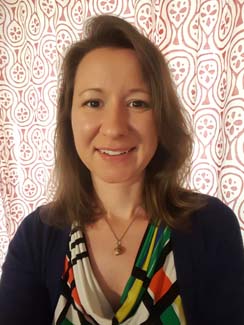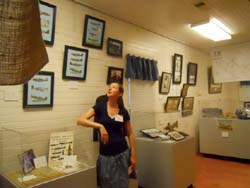Jenny Hay: Senior Management Analyst, City of San Antonio Office of Historic Preservation
 Jenny Hay, PhD is a historical geographer with a background in community outreach, advocacy, and digital humanities. Originally from Luling, Texas, Jenny earned degrees from the University of Texas at Austin and Texas State University-San Marcos before pursuing a doctorate in Geography & Anthropology at Louisiana State University in Baton Rouge. Her research explored questions related to resilience, heritage tourism, and historic preservation in cities across the southern United States. Hay's career pursuits have varied from implementing housing grants in rural Texas counties to managing the aerial photography collection at the LSU Map Library to opening a small museum in northwestern Louisiana. She also participated in disaster response operations for Hurricanes Rita and Katrina as well as the Deepwater Horizon Oil Spill in 2010. Most recently, Hay served as an intern and contractor for the National Center for Preservation Technology & Training in Natchitoches, Louisiana, and as Preservation Outreach Manager for the San Antonio Conservation Society.
Jenny Hay, PhD is a historical geographer with a background in community outreach, advocacy, and digital humanities. Originally from Luling, Texas, Jenny earned degrees from the University of Texas at Austin and Texas State University-San Marcos before pursuing a doctorate in Geography & Anthropology at Louisiana State University in Baton Rouge. Her research explored questions related to resilience, heritage tourism, and historic preservation in cities across the southern United States. Hay's career pursuits have varied from implementing housing grants in rural Texas counties to managing the aerial photography collection at the LSU Map Library to opening a small museum in northwestern Louisiana. She also participated in disaster response operations for Hurricanes Rita and Katrina as well as the Deepwater Horizon Oil Spill in 2010. Most recently, Hay served as an intern and contractor for the National Center for Preservation Technology & Training in Natchitoches, Louisiana, and as Preservation Outreach Manager for the San Antonio Conservation Society.
What led you to the preservation field?
I grew up with parents that planned family vacations around visits to historic sites, parks, and battlefields, so many of my childhood memories are imbued with a special connection to the past. In my studies, I was very fortunate to be able to explore and pursue those topics that piqued my curiosity. After graduating with a bachelor's degree in geography with a minor in history, I worked full time implementing housing grants while taking classes in the evening for my master's degree. The SHPO was referred to as the "hysterical commission" in my office (I'm sure many of us have heard that before). I was just naïve enough to think that if only we could improve the way we measured and promoted the positive aspects of historic preservation, we could avoid vilification and work together toward the economic development goals we all shared. I found a preservation project with a happy ending, wrote a thesis about it, and took the advice of my advisor to apply to the PhD program in the Geography & Anthropology department at Louisiana State University. I have always been motivated by research grounded in policy relevance, community engagement, and public history, so I anticipated that my career trajectory would take me outside of a university setting. I sought out volunteer opportunities, service learning courses, and internships to help round out my resume, and they led me to work at a nonprofit and now at the City of San Antonio Office of Historic Preservation.
How does what you do relate to historic preservation?
My current position allows me to implement our comprehensive survey and designation initiative, called ScoutSA. Along with community organizations, neighborhoods, students, and other volunteers, we inventory historic resources, identify properties eligible for landmark designation, and highlight authentic sites and neighborhoods that tell unique local stories. These three tenets of ScoutSA (discover, explore, celebrate) combine to create a proactive preservation agenda for San Antonio.
Why do you think historic preservation matters?
Preservation connects people to the past through the world around them. Engaging communities in a celebration of their stories, traditions, and places of significance can be an empowering experience for all of us.
What courses do you recommend for students interested in this field?
I always recommend coursework in the humanities. Some of my favorites included Public Anthropology, Material Culture & Vernacular Architecture, Cultural Landscapes, and Settlement Geography (which focused on the relationship between human and natural ecosystems). Courses with a writing and/or public speaking component are also pragmatic—so much of what we do involves communication with audiences that are dramatically different from ourselves and our colleagues!
Do you have a favorite preservation project? What about it made it special?
 While I was a student at LSU, my colleague, Gentry Hanks, and I partnered with a small group in the Village of Ida to open the Capt. Fletcher E. Adams 357th Fighter Group Museum. Over about six months, we learned so much from the community about the history of the ArkLaTex region and the incredible story of this fighter group that flew P-51s, which included well-known aces General Chuck Yeager and Colonel Bud Anderson. My grandfather was a P-51 mechanic in the Korean War and even owned one of the sporty fighter planes when my father was young. My grandmother was raised just 70 miles north of Ida in another tiny town called Ben Lomond, so I felt a special connection to these stories. The museum is located in the historic post office, so we included an interactive exhibit featuring vintage postal boxes where visitors could write and send postcards just like the families of soldiers and pilots would have done during WWII. General Yeager even attended the grand opening!
While I was a student at LSU, my colleague, Gentry Hanks, and I partnered with a small group in the Village of Ida to open the Capt. Fletcher E. Adams 357th Fighter Group Museum. Over about six months, we learned so much from the community about the history of the ArkLaTex region and the incredible story of this fighter group that flew P-51s, which included well-known aces General Chuck Yeager and Colonel Bud Anderson. My grandfather was a P-51 mechanic in the Korean War and even owned one of the sporty fighter planes when my father was young. My grandmother was raised just 70 miles north of Ida in another tiny town called Ben Lomond, so I felt a special connection to these stories. The museum is located in the historic post office, so we included an interactive exhibit featuring vintage postal boxes where visitors could write and send postcards just like the families of soldiers and pilots would have done during WWII. General Yeager even attended the grand opening!
Can you tell us what you are working on right now?
Our team just submitted a nomination for the Downtown San Antonio & River Walk National Register Historic District, and now I'm balancing my time between survey and designation efforts along corridors that lead to the San Antonio Missions World Heritage site, the San Antonio Zoo, and historic gas stations.
How do you think the national historic preservation programs help your community?
San Antonio has been a leader in historic preservation for nearly a century, and programs run by the National Park Service (NPS) are integral to local preservation. I already mentioned that we just submitted a nomination for a new National Register Historic District in order to make more structures eligible for the historic tax credit at the state and federal level. We also have eight National Historic Landmarks (hopefully nine after the Advisory Board meets this fall) and a UNESCO World Heritage Site. The Main Street program truly transformed Southtown, which is now one of the trendiest places to live, eat, work, and play in the city. Because we're a certified local government, we've also received grants from the NPS Historic Preservation Fund allocation to the Texas Historical Commission to research and nominate historic farm and ranch complexes for listing on the National Register of Historic Places.
Do you have advice for novice preservationists?
Talk to people about your passion, and get involved with organizations in your community. Be an advocate for preservation in your neighborhood, in your city, in your state. There are career opportunities in all directions for preservationists: as architects, curators, librarians, scholars, carpenters, attorneys, consultants, fundraisers, engineers, archaeologists, landscape architects, stonemasons, software developers, contractors, historians, and so much more!
The ACHP's mission is "preserving America's heritage;" can you give us an example of how your community is preserving its heritage?
It's hard to pick just one! But I do like public engagement, so I'll go with this one. Just a few years ago, the San Antonio Conservation Society (local nonprofit supporting preservation through grants, education, and advocacy) undertook the challenge of updating its nearly 30-year-old survey of historic gas stations. From Gulf to Humble and Magnolia to Texaco, the Texas economy relied heavily on the oil and gas industry in the early 20th century. These companies all sold gas under their own brands, and after San Antonio's last streetcars were removed in 1933, new businesses began emerging that catered to a growing market of automobile owners. The Alamo City was already an established tourist destination, so filling stations were a necessary commodity for families on road trips, just like motor courts and motels. The original survey focused on the oldest remaining stations in the central core, so this update broadened the scope by expanding to new areas along historic commercial corridors and including buildings constructed after 1940. Through a grant, the Conservation Society produced a digital portal for the public to access their survey results, including architectural descriptions, historic research, photos, and maps. In May 2016, the Historic Preservation Office and the Conservation Society co-hosted an event called "San Antonio or Bust" at a historic gas station that's now a popular local restaurant, where we shared the stories of these important everyday buildings with more than 60 attendees! As a result of this partnership, three dozen sites are now nominated for designation as local landmarks.
Read more Q&A stories about the preservationists in your neighborhood!